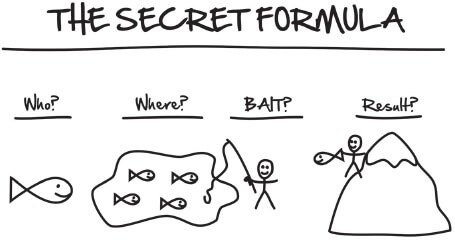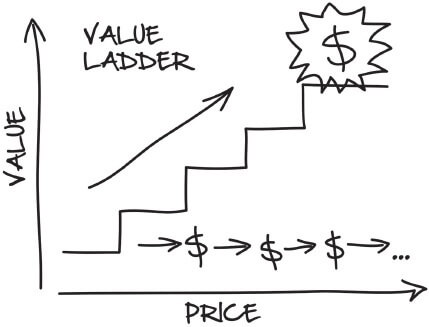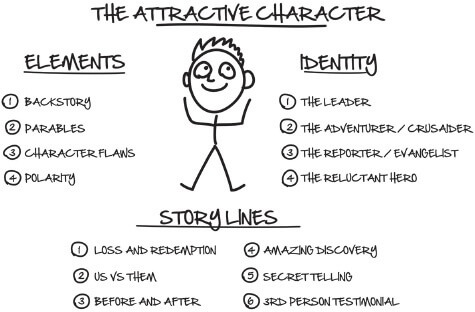Dotcom Secrets By Russell Brunson
These are my personal book notes of Dotcom Secrets by the author Russell Brunson.
If you’re in the process of starting your online business or want to get a better understanding of solid, direct response based marketing best practices applied in the online marketing world - this is your book.
You can find my book notes on Russell’s second book, Expert Secrets, here.
Now let’s dive in.
Facts
- Author: Russell Brunson
- Title: Dotcom Secrets
- Subtitle: The Underground Playbook For Growing Your Company Online
- First published: 2015
- Type: non-fiction
- Genre: business education / marketing
- Author’s website: russellbrunson.com
- Rating: 4.5/5
- Recommended: Yes
Table Of Contents Of The Book
- Foreword: What The ‘Online Marketing Wizard Fraternity’ Doesn’t Want You To Know (by Dan S. Kennedy)
- What This Book Is About
- Introduction
- Section One: Ladders and Funnels
- Secret #1: The Secret Formula
- Secret #2: The Value Ladder
- Secret #3: From a Ladder to a Funnel
- Secret #4: How to Find Your Dream Customers
- Secret #5: The Three Types of Traffic
- Section Two: Your Communication Funnel
- Secret #6: The Attractive Character
- Secret #7: The Soap Opera Sequence
- Secret #8: Daily Seinfeld Sequence
- Section Three: Funnelology Leading Your Customers to the Sale (Over and Over Again)
- Secret #9: Reverse Engineering a Successful Funnel
- Secret #10: Seven Phases of a Funnel
- Secret #11: The Twenty-Three Building Blocks of a Funnel
- Secret #12: Frontend vs. Backend Funnels
- Secret #13: The Best Bait
- Section Four: Funnels and Scripts
- Frontend Funnels
- Funnel #1: Two-Step, Free-Plus-Shipping
- Funnel #2: Self-Liquidating Offer
- Funnel #3: Continuity
- Funnels for the Middle of the Value Ladder
- Funnel #4: The Perfect Webinar
- Funnel #5: Invisible Funnel Webinar
- Funnel #6: Product Launch
- Backend Funnel
- Funnel #7: High-Ticket, Three-Step Application
- Section Five: ClickFunnels
- Conclusion: Ignite
Foreword: What The ‘Online Marketing Wizard Fraternity’ Doesn’t Want You To Know (by Dan S. Kennedy)
It is in the wizard’s best interest for you to believe everything in the online media, marketing and business world is shiny and new, constantly changing, and un-tethered from the old rules, principles, facts, and math of successful advertising and marketing.
This book by Russell Brunson is different.
While teaching you about the “shiny” secrets of the internet, he shows you how to build these tactics and strategies into your business on solid ground - tactics and strategies founded in true direct-response marketing.
It is your responsibility to resist the seduction of short-lived, bright and shiny lures, popularity and peer pressure, and the siren-songs of superficially knowledgeable promoters of ‘new’ tactics with no knowledge of its original direct response genealogy.
You must exercise discernment.
I taught myself direct marketing as a science.
I’m a reliability guy.
I’m far more interested in a car that starts and runs well and predictably every time you turn the key than one that looks sexy and is popular with some in-crowd, but might stall at 80 MPH or not start at all.
I like evergreen, not frequently obsolete.
In my roles as a strategic consultant and a direct-response copywriter, I am all about creating advertising, marketing, and sales assets of lasting value for my clients - not moneymaking devices written in disappearing ink.
That’s why I agreed to write the foreword for this online marketing wizard’s book.
I admire the truth Russell has put between these pages.
Unlike many of these wiz kids, Russell Brunson is grounded in direct marketing disciplines.
In truth, this is a proven playbook for growing your company with effective lead generation and sales/conversion methods, which can be used online and offline.
Solid and reliable and proven aren’t the sexiest positioning terms.
Don’t go into this book in lust for a new, cool, quick, easy “fix” or nifty “toy” or clever gimmick that might make you money today but require you to find another and another and another, at frantic pace.
Go into this book in search of deep understanding and profound clarity about the structure and science of effective marketing to be applied in the online media universe.
Introduction
When Google changes an algorithm or Facebook introduces a new layout, many tactics suddenly become obsolete.
This book, on the other hand, is a playbook for creating marketing funnels that will exponentially increase your sales online.
It is an evergreen guide.
It will be as useful ten years from now as it is today.
I only focus on strategies and concepts that will remain the same - even when technology changes.
Secret #1: The Secret Formula - Who, Where, Bait, Result

- Question #1: Who Is Your Dream Client?
- Who do I actually want to work with? Who are my dream clients? What do they look like? What are they passionate about? What are their goals, dreams, and desires?
- Question #2: Where Can You Find Them?
- Where can you find this ideal man or woman? Where do they hang out online? Are they on Facebook or Instagram? What groups are they part of? What email newsletters do they subscribe to? What blogs do they read? What other interests do they have?
- Question #3: What Bait Will You Use to Attract Them?
- Once we know where the dream customers are, we have to create the right bait to attract them. Your bait could be a physical book, a CD, DVD, or an audio recording – anything that your dream customer would pay attention to and want.
- Question #4: What Result Do You Want To Give Them?
- Once you’ve hooked your dream customers with the perfect bait, the last question is what RESULT do you want to give them? A business is NOT about products and services. A business is about what result you can get for your clients. Once you (and they) understand that concept, then price is no longer a barrier.
After I got a good idea of WHO I would ideally work with if I had that choice, I started to think about the RESULT I would want to give them.
I asked myself, “Where could I serve my customer at the highest level?”
- Russell Brunson
I realized it wasn’t through a product or a service.
Rather, it was by giving them a result that would change their lives.
That result is where I wanted to take them.
- Where are these people? How can I find them online?
- What type of bait can I create to attract my dream client and repel everyone else?
##Secret #2: The Value Ladder

The Secret Formula was created to help you figure out
- who you want to serve,
- how to find them,
- what kind of bait you should use to attract them, and
- where you want to take them.
The Value Ladder was created to help you figure out what products and services you need to add so that your dream clients move from your bait to your high-end services.
A funnel moves people through the sales process.

They enter as prospective customers (traffic), and your job is to convert as many as possible into repeat customers by selling to them at the front, middle, and backend of your funnel.
The deeper your funnel is, and the more things you can offer your clients, the more each customer will be worth to you.
And the more they are worth to you, the more you can spend to acquire them.
Ultimately, the business that can spend the most to acquire a customer, wins.
- Dan S. Kennedy
So a sales funnel is just the online process you take someone through to get them to ascend through the different levels of your Value Ladder.
It’s the actual webpages that will make the Secret Formula work.
The Secret Formula will help you find your dream customer, offer them your bait, and lead them to where you want them to go - all while providing the customer value and making you money.
Secret #5: The Three Types Of Traffic
There are just three types of traffic:
- Traffic you control
- Traffic you don’t control
- Traffic you own
Your one and only goal is to own all the traffic you can.
That is how you grow your list and increase your sales.
Traffic you own is the best kind of traffic.
It’s your email list or your followers, readers, customers, etc.
I call this the traffic that I “own” because I can send out an email, post a message to my followers, or make a blog post, and I will generate instant traffic.
I don’t have to buy it from Google or Facebook.
I don’t have to do any PR or SEO.
This is my own distribution channel; I can send out messages anytime I want, with no new marketing costs.
I can sell things to these people over and over again, and all of that money comes back as pure profit.
That’s why it’s so important to convert the other two types of traffic (both traffic you control and traffic you don’t control) into subscribers and buyers (traffic that you own) as quickly as possible.
The bigger your list, the more money you make.
Examples for traffic you control:
- In general: Paid traffic
- Solo ads, banners, links, mentions
- PPC (pay per click) ads (FB, Google, Yahoo etc.)
- Banner ads
- Native ads
- Affiliates and joint ventures
Examples for traffic you don’t control:
- Social media (Facebook, Twitter, Instagram, Google+, LinkedIn, Pinterest, etc.)
- Search traffic (search engine optimization or SEO)
- Guest blog traffic
- YouTube
- Guest interviews
Now, just like traffic that I control, my only goal with traffic that I don’t control is also to turn it into traffic that I own.
To do this, I try to push all traffic that I don’t control back to my blog.
If you visit any of my blogs, you’ll notice that the top third of my blog is nothing but a glorified squeeze page.
When people go there, the only real thing they can do is give me their email addresses.
After they do that, they become traffic that I own, and I can put them into my communication funnels.
Secret #6: The Attractive Character
It’s about the persona you’re sharing with your audience and how you communicate with your list.

Most people either don’t bother to create this character, or they don’t do it correctly.
So, I want to explain the process to you now.
It’s one of the most important steps you can take when it comes to making sales.
Once you intentionally create your AC, your business will change forever.
What I’m talking about here is a persona that attracts clients or customers and helps you build your following to eventually make sales.
That’s the power of Attractive Characters.
We love them. We want to be like them. We relate to their stories.
And we buy what they’re selling!
This is one of the big secrets behind the most successful online businesses in the most competitive markets, like weight-loss, dating, financial investing, supplements, and ecommerce.
All these types of businesses can use an Attractive Character.
This concept can mean the difference between making one thousand dollars a month and making one hundred thousand a month.
The 4 Elements Of The Attractive Character
- Backstory. Every good Attractive Character has to have a backstory. It’s essential if you want results.
- Attractive Characters Speak in Parables. Parables are little stories, easy to remember, that illustrate a relevant point.
- Attractive Characters Share Their Character Flaws. No one wants to hear about the perfect person - because you can’t relate. As soon as the audience knows you’re not perfect, that you have character flaws, then they will start to empathize with you. They’ll like you more because you are like them: not perfect.
- Attractive Characters Harness the Power of Polarity. Here’s the problem. While that sounds like the logical thing to do - appeasing everyone - the problem is that being neutral is boring. When an Attractive Character tries to win the votes of everyone, they end up reaching no one.
Identity Of An Attractive Character
Your Attractive Character will typically take on one of the following types of identities.
- The Leader
- The Adventurer or Crusader
- The Reporter or Evangelist
- The Reluctant Hero
Attractive Character Storylines
- Loss and Redemption
- Us vs. Them
- Before and After
- Amazing Discovery
- Secret Telling
- Third-Person Testimonial
Secret #7: The Soap Opera Sequence
When somebody joins your list for the first time, it’s essential that you quickly build a bond between them and the Attractive Character.
The way you introduce your character can mean the difference between a subscriber opening your emails consistently or hitting the delete key.
For years I tried dozens of ways to build a quick relationship with people after they joined my list, but I always struggled until I learned a concept called the Soap Opera Sequence from one of my friends, Andre Chaperon.
If your first email is boring, you’re done.
The five-email Soap Opera Sequence
- Email #1: Set the Stage
- Email #2: Open with High Drama
- Email #3: Epiphany
- Email #4: Hidden Benefits
- Email #5: Urgency and CTA
I’m not telling you to put errors in on purpose, but if they happen, don’t freak out.
And please don’t let fear of making a mistake keep you from sending out the emails at all.
If you follow the Soap Opera Sequence style, you’re going to be amazed by how much more successful you are - early on and as long as you continue to send emails to your list.
Secret #8: Daily Seinfeld Sequence
It was funny because the show Seinfeld actually was a show about nothing.
My emails switched from 100% content to 90% entertainment and just 10% content, and my readership, opens, clicks, and sales all skyrocketed with the change.
You want your Attractive Character to be fun and entertaining.
That’s how you’re going to write your daily Seinfeld emails.
That’s right; I recommend sending them daily after your initial Soap Opera Sequence is finished.
The secret to keeping your subscribers happy to hear from you every day is using the Seinfeld format.
Be entertaining. Just talk about your day.
- What’s going on in your Attractive Character’s life?
- What happened that’s embarrassing?
- How are you getting through the holiday season?
- Where are you planning your vacation this year?
- What did you buy recently that you regret?
- What did you buy recently that you just adore?
- What made you scream with rage yesterday, that you’re laughing about today?
- What crazy antics did your kid or your dog get into yesterday?
- What funny thing happened in your past that teaches a lesson?
The goal is to lead people back to whatever you’re selling.
Closing Thoughts
My book notes only cover small parts of the book.
So if you like what you read, please consider buying the book from the author.
Thank you for reading and stay awesome,
Tim for Online Business Dude
PS: Want To Start And Grow Your Own Online Business?
==> Download The Free Online Business Blueprint (PDF) Here. It’s 100% Free!
